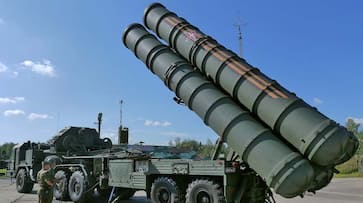With a tracking range of 600 km and a kill range of 400 km, the S-400 Triumf can hit targets at a blistering speed of 17,000 km an hour
Of all the many scary weapons that the Russian defence industry has developed over the past decades, the S-400 is among the scariest. Acknowledged by Western armament experts as the most lethal air defence system ever, it is a rare example of a tactical weapon with strategic impact. Because it was developed by Russia to defend its vast airspace, the S-400 – codenamed Triumf – becomes an even more potent weapon in the relatively confined spaces of India’s neighbourhood. It will give India the unprecedented capability of taking out aircraft and missiles while they are still in enemy airspace. In the military this is called a force multiplier.
With a tracking range of 600 km and a kill range of 400 km, the S-400 Triumf can hit targets at a blistering speed of 17,000 km an hour. No air-breathing aircraft in operation –or under development – can outrun its missiles because currently there is no aircraft that travels faster than 3,000 km per hour.
First deployed by Russia in 2010, each S-400 battalion has eight launchers, a control centre, radar and 16 missiles available as reloads. After two years of negotiations – and fending off relentless American pressure – India and Russia have finally inked a deal for five Triumf systems for $5.3 billion, with supplies slated for 2020.
Force multiplier: Why India needs the Triumf
Air defence is a critical aspect of war. If the enemy is able to penetrate your airspace, his first targets are high-value military targets like airfields and ordnance factories as well as high-value industrial establishments such as power plants, oil refineries, and transport networks.
Because it has a limited number of squadrons, the Indian Air Force cannot be at all places at all times. The long range of the S-400’s powerful AESA (active electronically scanned array) radar that can look over the horizon fills these gaps. The S-400 missile system can even take out aircraft with low-observable technology. “For the S-400 there is no such thing as ‘stealth’ aircraft; the system will see it and will shoot it down,” an S-400 battery commander was quoted as saying in the Russian media.
The S-400 can “see” everything both in the air and on the ground, and can easily discern even a tiny aircraft from, say, a truck moving on the ground, the commander added. “Even if a plane is flying low and with the same speed as a vehicle moving on the ground, the radar will show it on the screen.”
The S-400 is a modern iteration of the S-75 missile that famously shot down the American U-2 spy plane over Russia in 1960. The U-2, which was being flown by Gary Powers, was downed while it was flying at an extreme altitude of 70,000 feet. That was nearly 60 years ago; due to incremental improvements in Russian missile defence capability, the S-400 can hit targets at altitudes up to 607,000 feet. This exo-atmospheric capability allows the system to intercept intermediate-range ballistic missiles in their terminal phase.
Unlike the overhyped US Patriot missile that turned out to be a massive failure, the S-400 was designed to create an A2/AD (anti-access/area-denial) umbrella over the battlespace. Its tremendous reach means that this envelope can extend over enemy territory, complicating his defences.
“Given its extremely long range and effective electronic warfare capabilities, the S-400 is a game-changing system that challenges current military capabilities at the operational level of war,” Paul Giarra, president, Global Strategies and Transformation, told Defense News. In other words, the S-400 will have the “effect of turning a defensive system into an offensive system".
Pakistan: Vulnerable from all angles
The most devastating impact of India acquiring the S-400 Triumf will be on the Pakistani military’s psyche. The air defence system will increase the vulnerability of all Pakistani air assets, especially fighter aircraft, missiles, and drones, by several orders of magnitude. Its 600 km tracking range will allow just three S-400 battalions located on the border to cover all of Pakistan, except the western extremity of Balochistan. With Afghanistan having turned hostile and upending Pakistan’s grandiose plans of acquiring strategic depth, the S-400 will squeeze the operational capabilities of both Pakistan’s offensive and defensive assets.
Because of its blistering speed, an S-400 missile fired from Adampur Air Force Base, Punjab, will take just 65 seconds to hit a Pakistan Air Force F-16 flying over Sargodha. Ejection – rather than evasive action – would be the sensible option against a missile coming at you at that speed.
Bilal Khan writes in Quwa: "One would assume that India has every incentive to station a number of S-400 systems – potentially up to three – in fairly close proximity to Pakistan. Grounding the missile in the heart of Indian Punjab would enable India to stifle the PAF from flying in key areas in its Central Command theatre which is responsible for protecting Lahore, the country's inland economic hub and second largest city.”
The S-400’s deployment will widen the window of vulnerability of Pakistan’s air force, Army, and strategic missile forces.
*First up, PAF jets will be forced to operate hundreds of kilometres west of the Indian border and will have to fly in a narrow strip of airspace along the borders of Iran and Afghanistan.
*Secondly, they will not be able to come to the defence of their armour and troop concentrations which would be taking a pounding from Indian artillery and the Indian Air Force (IAF).
*The system also has the capability to hunt and kill cruise missiles, which will increase the vulnerability of Pakistan’s newly acquired Nasr and Babur missiles.
A single system can engage up to 36 targets simultaneously so a string of three such air defence regiments stationed on the western border will allow India to monitor all Pakistani aerial activity on a constant basis. Pakistan will lose the ability to launch surprise pre-emptive airstrikes against India. The S-400’s offensive-defense capability means IAF aircraft won’t have to undertake risky missions until the enemy airspace is sanitised.
Because the PAF’s offensive and defensive assets are stretched thin, the entry of the S-400 will force Pakistan to spend heavily on increased numbers of aircraft and missiles needed to neutralise the huge Indian advantage. Given the Pakistani military’s obsessive desire to achieve parity with India, it may even acquire the HQ-9 – the Chinese knockoff of the older Russian S-300 system.
With the Pakistani economy not exactly in the pink of health, the additional spending will come at the expense of economic growth needed to employ, feed and house its growing population. Disenchantment with the government’s policies will set in motion the kind of disaffection which led to the country’s breakup in 1971 and the creation of Bangladesh.
China: Neutralising stealth
Against China, the S-400 will be deployed primarily in an anti-stealth role. The PLA Air Force has already received small numbers of the J-20 stealth fighter, presenting a new threat to India which is unlikely to get a stealth jet in the near future. This is where the Russian system comes to the rescue.
Because the S-400’s radar can detect stealth aircraft, it will nullify the J-20’s ability to hide in the Himalayas. Chinese air assets in Tibet will also come within striking distance. Therefore, this new missile defence system will offer India a degree of protection against China’s most advanced warplanes.
China has contracted for six S-400 systems, but these are likely to be deployed along its eastern coastline in order to defend against the US Pacific Fleet’s air combat assets.
Working in sync: Enhanced firepower
While the S-400 is clearly a capable long-range weapon, air defence works best when all its components operate in sync. In fact, the Triumf becomes deadlier if it is used alongside short and medium-range missiles, anti-aircraft artillery (AAA) and fighter aircraft. By dominating high altitude airspace, the S-400 can drive enemy aircraft down into a “flak trap” where AAA batteries and air defence fighters await them. If the IAF can successfully integrate the S-400 into its multi-tier air defence system, it can significantly increase the costs for attacking air forces.
The system can also function as a ballistic missile killer until India’s indigenous Prithvi Defence Vehicle comes online in the coming decade.
Flip side: No tech transfer
While the S-400 will definitely enhance India’s warfighting capabilities, it won’t translate into any technology transfers. This is an outright buy that is outside the ambit of Make in India and defence offsets. Besides, it is unlikely the Russians would agree to help India license build the system as the Triumf is in great demand worldwide. The long line of buyers includes China, Turkey, Qatar and Iraq. Saudi Arabia – which has several batteries of the US Patriot system – had also expressed interest. However, the Saudis were quickly forced to backtrack by the Americans who didn’t want their number one arms buyer to abandon the US made Patriot.
On a sobering note, it remains to be seen whether the Russians are willing to supply the full-on system or a stripped-down export version. The S-400 uses four missiles to fill its performance envelope:
*Very-long-range 40N6 (400 km)
*Long-range 48N6 (250 km)
*Medium-range 9M96E2 (120 km)
*Short-range 9M96E (40 km).
The 40N6 missile with its high explosive warhead is what gives the system its preternatural edge. For reasons of secrecy we may never know which of these missiles have been contracted for. However, if Indian negotiators have succeeded in persuading the Russians to supply the 40N6, it would allow the IAF to deploy the system at its most lethal level.
Whatever configuration the Russians supply, India should try and graft some of the best features of the S-400 on to its indigenous missile defence system. It should reverse engineer the Russian system if necessary. Unlike China, which strips apart imported weapons and quickly brings knockoffs to the market, India has been extremely reticent about reverse engineering weapons.
In 2004 the Ordnance Factory Board (OFB) had produced a clone of the legendary AK-47 assault rifle and displayed it at Defexpo. In a freaky coincidence Mikhail Kalashnikov, the rifle’s designer happened to be visiting the exhibition and saw the displayed prototype. The Russian army general took the matter up with the Indian authorities and requested the OFB to withdraw its “illegal copy”. India quickly shelved the weapon.
Last Updated Oct 9, 2018, 9:30 AM IST









![Salman Khan sets stage on fire for Anant Ambani, Radhika Merchant pre-wedding festivities [WATCH] ATG](https://static-gi.asianetnews.com/images/01hr1hh8y86gvb4kbqgnyhc0w0/whatsapp-image-2024-03-03-at-12-24-37-pm_100x60xt.jpg)
![Pregnant Deepika Padukone dances with Ranveer Singh at Anant Ambani, Radhika Merchant pre-wedding bash [WATCH] ATG](https://static-gi.asianetnews.com/images/01hr1ffyd3nzqzgm6ba0k87vr8/whatsapp-image-2024-03-03-at-11-45-35-am_100x60xt.jpg)


